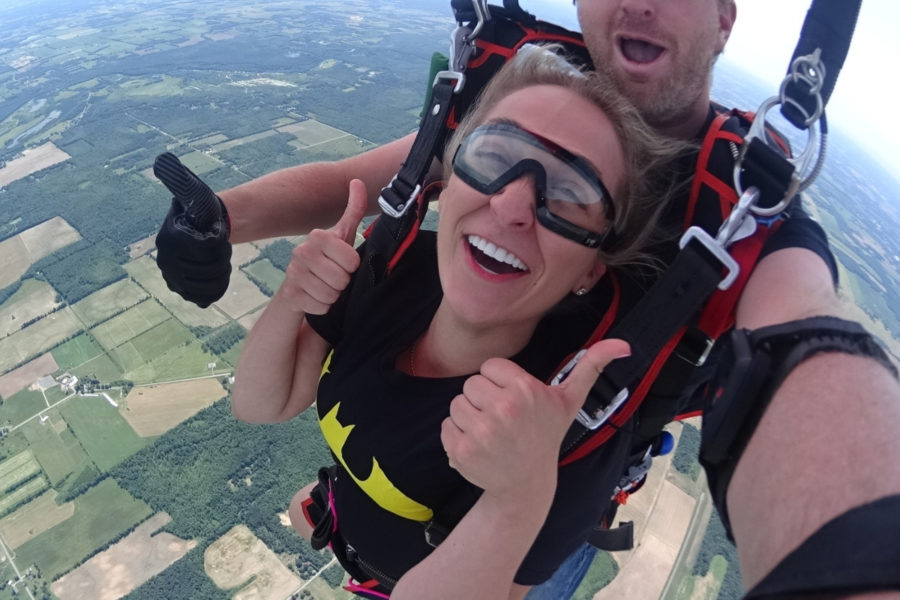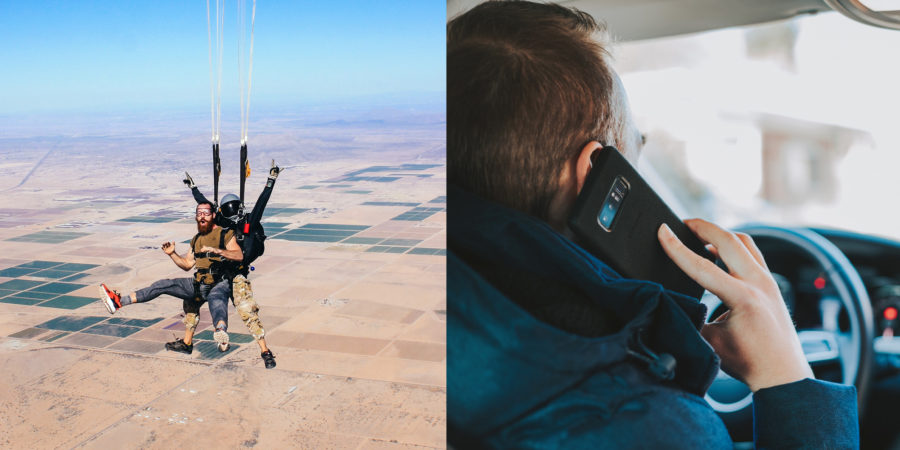Is parachuting safe? It’s a common question, and for good reason. Jumping out of an airplane mid-flight from a few miles up is an obviously risky activity. Over the last several decades, we’ve figured out how to mitigate the risk through a standardization of skydiving safety standards, rules, and training requirements, and through the development of sophisticated gear and tech. Even with stringent checks and balances, though, skydiving is not “safe.”
In this article, we’ll consider skydiving safety statistics against some safety statistics we’re more familiar with. We’ll also answer some more frequently asked questions along the way, including one we hear all the time: is skydiving safer than driving?
Skydiving’s Governing Body: USPA
Let’s start with what we know best: skydiving. The United States Parachute Association (USPA) is the governing body for our sport. There are hundreds of USPA member dropzones across the globe, including WNY Skydiving, all of which are required to:
- Comply with the USPA’s Basic Safety Requirements
- Engage only USPA-certified instructors
- Use USPA-approved equipment
- Implement USPA-developed instructional methods

The USPA has been recording and analyzing skydiving safety statistics since 1961. Trends in the data answer questions like, “How common are skydiving accidents?” and, “What is the failure rate of skydiving equipment?” Answers to these and other important questions inform decisions about how to make our sport safer.
Skydiving Safety Statistics
So, what does the data collected by the USPA tell us? Let’s look at some of the numbers from the last 20 years.
| Year | Total USA Skydives | Skydiving Fatalities | Fatalities/100K Jumps |
| 2023 | 3.65 million | 10 | 0.27 |
| 2018 | 3.3 million | 13 | 0.39 |
| 2013 | 3.2 million | 24 | 0.75 |
| 2008 | 2.6 million | 30 | 1.15 |
| 2003 | 2.6 million | 25 | 0.96 |
As is clear, the number of skydives has consistently increased year over year, the number of fatalities has decreased, and the fatality rate has improved.
Driving Safety Statistics
Information available from the Federal Highway Administration (FHWA) and the National Highway Traffic Safety Administration (NHTSA) allows us to consider the total number of licensed drivers, total number of fatal car accidents and crash-related fatalities, and the driving fatalities per 100,000 drivers for the same time period. The information is not directly apples-to-apples because it’s per driver not per trip, but the data is compelling nonetheless.
| Year | Total USA Drivers | Driving Fatalities | Fatalities/100K Drivers |
| 2023 | 243.0 million | 40,760 | 16.78 |
| 2018 | 227.3 million | 36,935 | 16.25 |
| 2013 | 212.2 million | 32,719 | 15.42 |
| 2008 | 201.7 million | 37,423 | 18.54 |
| 2003 | 190.6 million | 42,884 | 22.5 |
Are you surprised to see the skydiving accident rate compared to the driving rate, i.e. 0.27 fatalities per 100,000 skydives versus 16.78 fatalities per 100,000 drivers in 2023? Most people are! Why? Let’s jump into this topic next.
We’re Used to the Risks Inherent to Driving
The way that humans perceive risk isn’t always fully rooted in logic. We can easily become desensitized to risks that we are over-exposed to or that we understand as necessary. Most people in the first world spend a lot of time in cars. Most of us were driven home from the hospital as a newborn and basically haven’t left the car since. And we’ve generally held drivers’ licenses since age 16.
Being in a car is 100% normal, which makes the risks involved part of our emotional furniture. Now, if we’re talking logic, they shouldn’t be. Driving remains one of the leading causes of preventable death for Americans across age groups, socioeconomic categories, and ethnic lines. Driving cars has been – and continues to be – the single most dangerous activity most people perform on any given day.
Skydiving, on the other hand, is a novelty for most people, and the media – which follows a “if it bleeds, it leads” culture – sensationalizes the sport.
This leads us to a very interesting phenomenon: The same person that spends half their commute to the dropzone texting while driving will still get freaked out about making a skydive. Bit ironic, no?

Skydiving Safety Gear
Skydiving is often thought of as a devil-may-care activity for adrenaline junkies with a death wish – but that couldn’t be farther from the truth. We jump from planes because we love it, and we want to do it for a long, long time, thank you very much! We take safety extremely seriously.
Let’s look closer at the equipment we use. We jump with two parachutes – a main and a reserve, or backup, parachute. Both are packed by trained professionals, with the reserve parachute being thoroughly inspected and repacked every 180 days (regardless of whether it’s been deployed) by a packer certified by the Federal Aviation Administration (FAA).
Every tandem skydiving rig is equipped with an automatic activation device (AAD) which does exactly what the name implies – it automatically deploys the parachute in the event the tandem instructor isn’t able to do so, for any reason. We all jump with a reserve static line (RSL) too, which initiates the deployment of the reserve in the event the main parachute is intentionally cut away.
As a tandem skydiving student, you jump with a large main parachute that’s designed to fly in a docile manner. Experienced skydivers, in contrast, jump with zippy little parachutes that fly much more aggressively. Tandem students get a big-time thrill from jumping into the boundless blue sky, freefalling at 120 mph, sailing under the parachute, and then landing back on the ground. Experienced skydivers want more, and do a whole lot more between jumping out and touching down.
It’s for these reasons, in part, that the vast majority of skydiving accidents and incidents involve experienced jumpers – they intentionally push boundaries and test limits. Case in point, over the past decade, there has only been one student fatality per 500,000 tandem jumps, and there were zero tandem skydiving fatalities in 2023.
What is Riskier than Skydiving?
There are plenty of activities besides driving that are riskier than skydiving from a statistical standpoint, some of which you probably risk the chance of encounter with regularly. Let’s take a look at some of the other things that are more statistically more dangerous than jumping out of an airplane. According to the National Safety Council, these were the odds of dying in 2022 by:
- Falling: 1 in 92
- Choking on food: 1 in 2,482
- Dog Attack: 1 in 43,882
- Hornet, wasp, or bee stings: 1 in 46,744
Considering the skydiving fatality rate for 2023 as reported by the USPA, i.e. 0.27 per 100,000 jumps, the odds of dying while skydiving are 1 in 370,370.
Calculated Risk is a Fact of Life
As you can see, whether you’re sitting at home eating donuts, driving your car, or jumping out of an airplane, one simple, universal fact is the same: Living a risk-free life is not possible. We all know someone who seems bent on removing every last risk from their life or the lives of their children, and it looks bonkers from an outside perspective, right? Because striving to take all risks out of our lives at the expense of the experiences that enrich us means we’re bound to stifle the reasons life is worth living in the first place!
If you have to accept risk as part of life, you might as well enjoy it! In that vein, tandem skydiving with a reputable dropzone is just the ticket. If you have any questions, we’re here to answer them. Don’t be shy – call us today!





